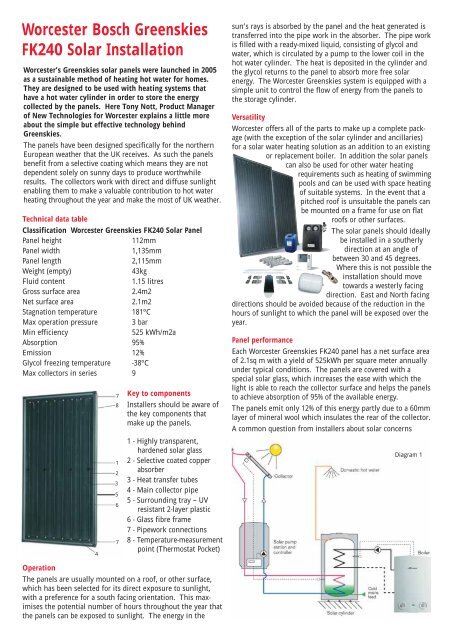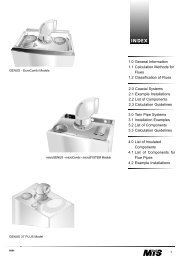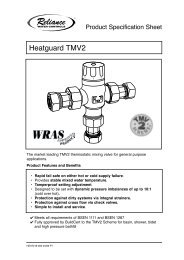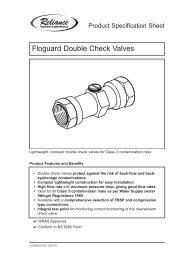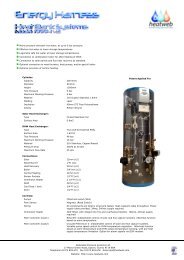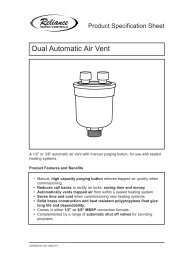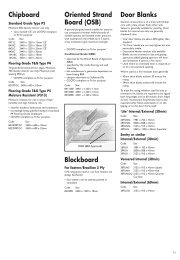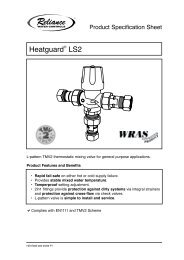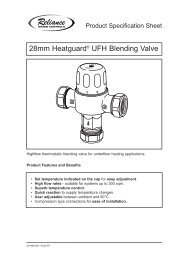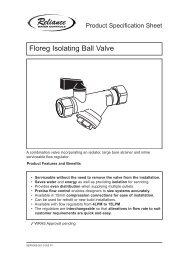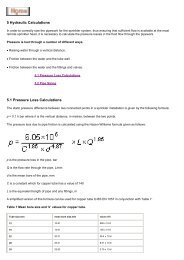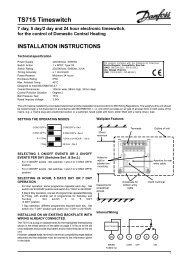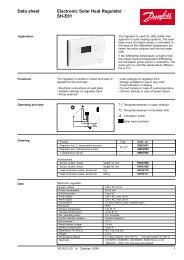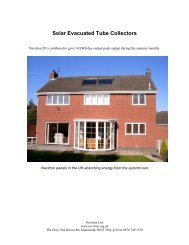Worcester Bosch Greenskies FK240 Solar Installation - Heatweb
Worcester Bosch Greenskies FK240 Solar Installation - Heatweb
Worcester Bosch Greenskies FK240 Solar Installation - Heatweb
You also want an ePaper? Increase the reach of your titles
YUMPU automatically turns print PDFs into web optimized ePapers that Google loves.
<strong>Worcester</strong> <strong>Bosch</strong> <strong>Greenskies</strong><br />
<strong>FK240</strong> <strong>Solar</strong> <strong>Installation</strong><br />
<strong>Worcester</strong>’s <strong>Greenskies</strong> solar panels were launched in 2005<br />
as a sustainable method of heating hot water for homes.<br />
They are designed to be used with heating systems that<br />
have a hot water cylinder in order to store the energy<br />
collected by the panels. Here Tony Nott, Product Manager<br />
of New Technologies for <strong>Worcester</strong> explains a little more<br />
about the simple but effective technology behind<br />
<strong>Greenskies</strong>.<br />
The panels have been designed specifically for the northern<br />
European weather that the UK receives. As such the panels<br />
benefit from a selective coating which means they are not<br />
dependent solely on sunny days to produce worthwhile<br />
results. The collectors work with direct and diffuse sunlight<br />
enabling them to make a valuable contribution to hot water<br />
heating throughout the year and make the most of UK weather.<br />
Technical data table<br />
Classification <strong>Worcester</strong> <strong>Greenskies</strong> <strong>FK240</strong> <strong>Solar</strong> Panel<br />
Panel height<br />
112mm<br />
Panel width<br />
1,135mm<br />
Panel length<br />
2,115mm<br />
Weight (empty)<br />
43kg<br />
Fluid content<br />
1.15 litres<br />
Gross surface area 2.4m2<br />
Net surface area 2.1m2<br />
Stagnation temperature 181ºC<br />
Max operation pressure 3 bar<br />
Min efficiency<br />
525 kWh/m2a<br />
Absorption 95%<br />
Emission 12%<br />
Glycol freezing temperature -38ºC<br />
Max collectors in series 9<br />
4<br />
7<br />
8<br />
1<br />
2<br />
3<br />
5<br />
6<br />
7<br />
Key to components<br />
Installers should be aware of<br />
the key components that<br />
make up the panels.<br />
1 - Highly transparent,<br />
hardened solar glass<br />
2 - Selective coated copper<br />
absorber<br />
3 - Heat transfer tubes<br />
4 - Main collector pipe<br />
5 - Surrounding tray – UV<br />
resistant 2-layer plastic<br />
6 - Glass fibre frame<br />
7 - Pipework connections<br />
8 - Temperature-measurement<br />
point (Thermostat Pocket)<br />
sun’s rays is absorbed by the panel and the heat generated is<br />
transferred into the pipe work in the absorber. The pipe work<br />
is filled with a ready-mixed liquid, consisting of glycol and<br />
water, which is circulated by a pump to the lower coil in the<br />
hot water cylinder. The heat is deposited in the cylinder and<br />
the glycol returns to the panel to absorb more free solar<br />
energy. The <strong>Worcester</strong> <strong>Greenskies</strong> system is equipped with a<br />
simple unit to control the flow of energy from the panels to<br />
the storage cylinder.<br />
Versatility<br />
<strong>Worcester</strong> offers all of the parts to make up a complete package<br />
(with the exception of the solar cylinder and ancillaries)<br />
for a solar water heating solution as an addition to an existing<br />
or replacement boiler. In addition the solar panels<br />
can also be used for other water heating<br />
requirements such as heating of swimming<br />
pools and can be used with space heating<br />
of suitable systems. In the event that a<br />
pitched roof is unsuitable the panels can<br />
be mounted on a frame for use on flat<br />
roofs or other surfaces.<br />
The solar panels should ideally<br />
be installed in a southerly<br />
direction at an angle of<br />
between 30 and 45 degrees.<br />
Where this is not possible the<br />
installation should move<br />
towards a westerly facing<br />
direction. East and North facing<br />
directions should be avoided because of the reduction in the<br />
hours of sunlight to which the panel will be exposed over the<br />
year.<br />
Panel performance<br />
Each <strong>Worcester</strong> <strong>Greenskies</strong> <strong>FK240</strong> panel has a net surface area<br />
of 2.1sq m with a yield of 525kWh per square meter annually<br />
under typical conditions. The panels are covered with a<br />
special solar glass, which increases the ease with which the<br />
light is able to reach the collector surface and helps the panels<br />
to achieve absorption of 95% of the available energy.<br />
The panels emit only 12% of this energy partly due to a 60mm<br />
layer of mineral wool which insulates the rear of the collector.<br />
A common question from installers about solar concerns<br />
Diagram 1<br />
Operation<br />
The panels are usually mounted on a roof, or other surface,<br />
which has been selected for its direct exposure to sunlight,<br />
with a preference for a south facing orientation. This maximises<br />
the potential number of hours throughout the year that<br />
the panels can be exposed to sunlight. The energy in the
Diagram 2<br />
of the equivalent of two tiles should be allowed for to avoid<br />
damage at the roof ridge, particularly if the tiles are laid in<br />
mortar.<br />
Dimension D shows the roof height including the gable wall.<br />
The adjacent 50cm clearance to the collector array is required<br />
under the roof on the right or left depending on the type of<br />
connection.<br />
Dimension E represents at least 30cm, which is required in<br />
the loft for installation of the connection pipes.<br />
Dimension F corresponds to at least 40cm, which is required<br />
in the loft for installation of the connection pipes.<br />
Diagram 3<br />
whether there is enough sun in the UK to make the installation<br />
of solar worthwhile. The usual idea of British weather is<br />
of cloudy skies with intermittent sunshine. The panels have<br />
been developed with this typical weather in mind and make<br />
the most of both direct and diffuse sunlight to give a useful<br />
annual contribution.<br />
System Layout<br />
The most common solar system layout uses a twin coil<br />
cylinder, which is fed by both a boiler (or other heat source)<br />
and the solar panels (see diagram 1). The solar system and<br />
the regular heating system do not come into direct contact<br />
with each other and the only shared part is the cylinder. The<br />
solar system has its own pump, expansion vessel, pressure<br />
relief valve, air vent and controller.<br />
Planning<br />
Planning requirements should always be checked with the<br />
local authority prior to beginning on the solar installation.<br />
Requirements vary from one authority to the next. In general<br />
the installation of solar panels, as far as planning permission<br />
is concerned, is reasonably straight-forward. Most local<br />
authorities regard the panels in a similar vein to flush fitting<br />
roof-light windows, and so planning permission may not be<br />
required.<br />
Site preparation/portability<br />
The panels need to be sited at 30-45 degree tilt, ideally facing<br />
south and away from sources of shade. Particular attention<br />
should be paid to site access and the safe installation of the<br />
panels. When working at height the required safety equipment<br />
should be correctly used.<br />
Panel dimensions and clearances<br />
Dimension A and B correspond to the area required for the<br />
selected number and layout of the panels. (see diagram 2)<br />
Dimension C signifies at least two tiles to the ridge. A space<br />
Panel support assembly<br />
Each panel is secured onto a pair of rails, which can be assembled<br />
on the ground and then raised to the roof. The rails can<br />
then be mounted on the roof hooks, which are available to<br />
suit various roof and tile types. (see diagram 3)<br />
In addition, the <strong>Worcester</strong> <strong>Greenskies</strong> <strong>FK240</strong> <strong>Solar</strong> Panels are<br />
available with a support kit for installation on flat surfaces,<br />
offering greater possibilities for installation.<br />
Connecting profile rails<br />
Individual rails are joined with a rail connector into which the<br />
rails slide, for an easy connection. (see diagram 4)<br />
Diagram 4<br />
Pipework Connections<br />
The solar panels are equipped with simple push-fit connections.<br />
These speed installation and, with bespoke flexible<br />
hoses, aid the routing of pipework into the roof space. Once<br />
inside the property the system should be run in copper pipe.<br />
Flexible hose connections are secured with a simple quick<br />
release clip which closes automatically and allows the time<br />
required for pipework connections on the roof to be reduced.<br />
(see diagram 5)<br />
Subsequent collectors in series also use this connection method<br />
to enable arrays to be plumbed in with ease. The second<br />
panel (of a two panel array) can be added easily with push-fit<br />
connections (see diagram 6).<br />
The UK market for solar is, at present, relatively untapped.<br />
According to the European <strong>Solar</strong> Thermal Industry Federation
Diagram 5<br />
(ESTIF) the solar thermal market in Europe grew by 12% in<br />
2004, however, the UK has a long way to go to match other<br />
European countries,<br />
especially Germany,<br />
which accounted for<br />
47% of the European<br />
market. The UK<br />
accounted for only<br />
2%. With the growing<br />
awareness of<br />
solar thermal and<br />
Diagram 6<br />
financial assistance<br />
available in government grants the UK contribution to the<br />
total European market is set to increase. Installers that are<br />
looking to offer fuel saving solutions to their customers as<br />
well as expand their business offering should seriously<br />
consider supplying solar.<br />
Cylinders<br />
To make the most of summer sunlight and the higher potential<br />
energy gains, a two panel system should ideally be combined<br />
with a 300 litre cylinder. Where this is not possible, for<br />
example where insufficient space is available, a recommended<br />
minimum of 200 litres storage can be used.<br />
<strong>Installation</strong> requirements<br />
The installation of the system must be carried out in<br />
accordance with the relevant requirements for safety, current<br />
Wiring Regulations, local Building Regulations, Building<br />
Standards (Scotland), (Consolidation) Regulations, Water<br />
Regulations and Health and Safety document No. 63S<br />
(Electricity at Work Regulations 1989).<br />
Insulation<br />
Exposed pipework should be covered with insulation rated to<br />
150 degrees centigrade due to the high temperatures that the<br />
panels are able to generate.<br />
Controls<br />
The solar package includes a simple controller (TDS10), which<br />
allows the user to select the temperature required at the hot<br />
water cylinder. The controller then automatically decides<br />
when to run the pump to bring the energy from the panels to<br />
the cylinder.<br />
The control uses a simple temperature differential to define<br />
when the pump runs. The temperature in the panel must be<br />
8 degrees higher than the store for the pump to start running.<br />
This will continue until the panel temperature is 4 degrees<br />
above the store and then the pump will stop. This ensures<br />
that the pump is running only when the benefit from the<br />
solar panels is available.<br />
Pressure relief valve<br />
The AGS2 <strong>Solar</strong> pump station in the <strong>Worcester</strong> <strong>Greenskies</strong><br />
<strong>FK240</strong> solar package is equipped with a 3 bar pressure relief<br />
valve which should be connected to pipe work terminating in<br />
a suitable container. An empty canister of heat transfer fluid<br />
can be used for this purpose.<br />
<strong>Solar</strong> Radiation in the British Isles<br />
The UK actually receives around 65% of the amount of solar<br />
radiation that is received by the south of Spain. Summer as<br />
expected will provide the largest amount of radiation over the<br />
year but a useful contribution will be provided by other seasons.<br />
The contribution towards the hot water requirement<br />
over the year changes with the hours and intensity of daylight<br />
so, as an indication, a well-sized typical installation will provide<br />
80-90 per cent during summer, 40-50 per cent during<br />
spring and autumn and 20-30 per cent during winter.<br />
This translates to roughly half of the typical annual domestic<br />
hot water requirement over a 12 month period.<br />
If this article has peaked your interest why not take it a step<br />
further? <strong>Worcester</strong> also offers a one-day training course on<br />
solar installation. For more details log onto<br />
www.worcester-bosch.co.uk or call 01905 752526.<br />
Electricity supply<br />
A fused three-pin plug and unswitched shuttered socket outlet<br />
(both complying with BS 1363) or preferably a double pole isolator<br />
with a contact separation of 3mm in all poles supplying<br />
the controller should be used. The controller must be earthed.<br />
Glycol heat transfer liquid<br />
<strong>Worcester</strong> <strong>Greenskies</strong> <strong>FK240</strong> <strong>Solar</strong> Panels and system components<br />
should be used only with the recommended heat transfer<br />
liquid -- TyfocorCL manufactured by Tyforop Chemie<br />
GmbH. The heat transfer liquid uses a proven concentration<br />
of anti-freeze and water to give protection against freezing and<br />
provide optimum performance from the panels and system.<br />
Hot water blending valve<br />
It is recommended a thermostatic blending valve be used in<br />
conjunction with the solar cylinder in order to guard against<br />
the high hot water temperatures, which the system can<br />
provide.<br />
This article, was first published in the MAY/JUNE 2006 issue of<br />
P&HE magazine and has been reproduced with the kind<br />
permission of <strong>Worcester</strong>, <strong>Bosch</strong> Group.


